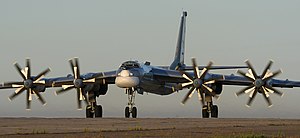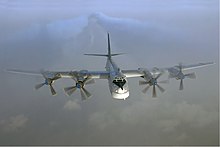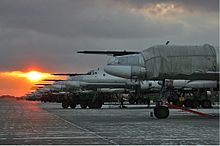Tupolev Tu-95: Difference between revisions
| Line 70: | Line 70: | ||
There are tales of the Soviet pilots suddenly swerving to push the escorts off course or cause them to rapidly decelerate. This went both ways, however. In the 1980s, a [[Royal Norwegian Air Force]] [[F-16 Fighting Falcon|F-16]] collided with a Tu-95 while escorting it out of [[Norway|Norwegian]] airspace. Apparently, the Norwegian pilot had been edging closer and closer to the Tupolev before being caught in the [[Wingtip vortices|prop wash]] and having a wingtip torn off in the resulting collision. Both aircraft landed safely. |
There are tales of the Soviet pilots suddenly swerving to push the escorts off course or cause them to rapidly decelerate. This went both ways, however. In the 1980s, a [[Royal Norwegian Air Force]] [[F-16 Fighting Falcon|F-16]] collided with a Tu-95 while escorting it out of [[Norway|Norwegian]] airspace. Apparently, the Norwegian pilot had been edging closer and closer to the Tupolev before being caught in the [[Wingtip vortices|prop wash]] and having a wingtip torn off in the resulting collision. Both aircraft landed safely. |
||
As late as 1999, Russian Tu-95s, usually flying in pairs, have come within striking distance both of the [[Iceland]]/[[Greenland]] route of North Atlantic and Alaska/Bering Sea route of North Pacific. In June 1999, the Tu-95s, along with two [[Tupolev Tu-160|Tu-160s]], turned back after being intercepted by U.S. fighters. A similar incident occurred in September but the Tu-95s turned back without making contact. |
As late as 1999, Russian Tu-95s, usually flying in pairs, have come within striking distance both of the [[Iceland]]/[[Greenland]] route of the North Atlantic and the Alaska/Bering Sea route of the North Pacific. In June 1999, the Tu-95s, along with two [[Tupolev Tu-160|Tu-160s]], turned back after being intercepted by U.S. fighters. A similar incident occurred in September but the Tu-95s turned back without making contact. |
||
More recently in July 2007 during the diplomatic row between Great Britain and Russia over the murder of ex-Russian spy [[Alexander Litvinenko]], Royal Air Force Tornadoes were scrambled to intercept Tu-95s which were apparently "probing" UK airspace in an event reminiscent of Cold War hostilities.<ref>[http://news.bbc.co.uk/1/hi/uk/6981541.stm "UK jets shadow Russian bombers."] ''BBC News'', 6 July 2007. Retrieved: 5 June 2010.</ref> |
More recently in July 2007 during the diplomatic row between Great Britain and Russia over the murder of ex-Russian spy [[Alexander Litvinenko]], Royal Air Force Tornadoes were scrambled to intercept Tu-95s which were apparently "probing" UK airspace in an event reminiscent of Cold War hostilities.<ref>[http://news.bbc.co.uk/1/hi/uk/6981541.stm "UK jets shadow Russian bombers."] ''BBC News'', 6 July 2007. Retrieved: 5 June 2010.</ref> |
||
Revision as of 19:04, 6 July 2010
| Tu-95 | |
|---|---|

| |
| Tu-95MS at Engels Air Force Base | |
| Role | Strategic bomber, missile carrier, airborne surveillance |
| Manufacturer | Tupolev |
| First flight | November 12, 1952 |
| Introduction | 1956 (MS — 1981) |
| Status | Active in service |
| Primary user | Soviet Air Forces Soviet Navy Russian Air Force |
| Number built | 500+ |
| Variants | Tupolev Tu-114 Tupolev Tu-119 Tupolev Tu-142 |
The Tupolev Tu-95 (Russian: Туполев Ту–95) (NATO reporting name: Bear) is a large, four-engine turboprop powered strategic bomber and missile platform.
First flown in 1952, the Tu-95 was put into service by the former Soviet Union in 1956 and is expected to serve the Russian Air Force until at least 2040.[1].
Commonly referred to even in Russia by its NATO designation, "Bear"[2], the aircraft has four Kuznetsov NK-12 engines, each driving contra-rotating propellers. It remains the fastest propeller-driven aircraft in history (a bigger, heavier, passenger version Tu-114 with de-rated engines, holds the FAI certified world speed record at 541.23 mph average speed on a 1000 km closed circuit carrying a load equivalent to only 200kg short of the weight of three Douglas DC-3's. Some experimental aircraft were designed for theoretically higher speeds, but none attained or registered them.) It also remains the only turboprop-powered strategic bomber in operational use. Its distinctively swept-back wings are at 35 degrees, a very sharp angle by the standards of propeller-driven aircraft, and justified by its operating speeds and altitudes.
A naval development of the bomber is designated Tu-142.
Design and development


The design bureau led by Andrei Tupolev designed the Soviet Union's first intercontinental bomber, the 1949 Tu-85, a scaled up version of the Tu-4, a Boeing B-29 Superfortress copy. The Tu-4 was deemed to be inadequate against the new generation of American all-weather interceptors.
A new requirement was issued to both Tupolev and Myasishchev design bureaus in 1950: the proposed bomber had to have an un-refueled range of 8000 km (4,970 mi) — far enough to threaten key targets in the United States. Other goals included the ability to carry an 11,000 kg (12 ton) load over the target.
The big problem for Tupolev was the engine choice: the Tu-4 showed that piston engines were not powerful enough to fulfill that role, while the fuel-hungry AM-3 jet engines of the proposed T-4 intercontinental jet bomber did not provide adequate range.[3] Turboprops offered more power than piston engines and better range than jets, with a top speed in between.

Tupolev's proposal was selected and Tu-95 development was officially approved by the government on 11 July, 1951. It featured four Kuznetsov, [4] coupled turboprops fitted with eight-bladed contra-rotating propellers, producing a nominal 8,948 kW (12,000 eshp) power rating. Unlike the advanced engine design, the fuselage was conventional: a high-wing cantilever monoplane with 35 degrees of sweep, an angle which ensured the main wing spar passed through the fuselage in front of the bomb bay. Retractable tricycle landing gear was fitted, with all three gear strut units retracting rearwards, with the main gear units retracting rearwards into extensions of the inner engine nacelles. The Tu-95/I, with 2TV-2F engines, first flew November 11, 1952 with test-pilot Alexey Perelet at the controls, but suffered a propeller gearbox failure and crashed.[5] The second aircraft, Tu-95/II featured four of the 12,000 ehp Kuznetsov NK-12 turboprops which proved more reliable than the coupled 2TV-2F. After a successful flight testing phase, series production of the Tu-95 started in January 1956.[4]
For a long time, the Tu-95 was known to U.S./NATO intelligence as the Tu-20. While this was the original Soviet Air Force designation for the aircraft, by the time it was being supplied to operational units it was already better known under the Tu-95 designation used internally by Tupolev, and the Tu-20 designation quickly fell out of use in the USSR. Since the Tu-20 designation was used on many documents acquired by U.S. intelligence agents, the name continued to be used outside the Soviet Union.
Initially the United States Department of Defense did not take the Tu-95 seriously, as estimates showed it had a maximum speed of 644 km/h (400 mph) with a range of 12,500 km (7,800 mi).[6] These numbers had to be revised upward numerous times.
Like its American counterpart, the Boeing B-52 Stratofortress, the Tu-95 has continued to operate in the Russian Air Force while several subsequent iterations of bomber design have come and gone. Part of the reason for this longevity was its suitability, like the B-52, for modification to different missions. Whereas the Tu-95 was originally intended to drop free-falling nuclear weapons, it was subsequently modified to perform a wide range of roles, such as the deployment of cruise missiles, maritime patrol (Tu-142), and even civilian airliner (Tu-114). An AWACS platform (Tu-126) was developed from the Tu-114. During and after the Cold War, the Tu-95's utility as a weapons platform has been eclipsed only by its usefulness as a diplomatic icon.
Tu-116

Designed as a stopgap in case the Tu-114A was not finished on time, two Tu-95 bombers were fitted with passenger compartments. Both aircraft had the same layout: a 3-seat VIP section with office space, and the rest of the 70 m³ cabin configured as a normal airliner. Both planes were eventually used as crew ferries by the various Tu-95 squadrons. One of these machines is preserved at Ulyanovsk Central Airport.
Operational history
Cold War icon
The Tu-95RT variant in particular was a veritable icon of the Cold War as it performed a vital maritime surveillance and targeting mission for other aircraft, surface ships and submarines. It was identifiable by a large bulge under the fuselage, which housed a radar antenna that was used to search for and target surface ships. The US Navy placed high priority in intercepting the Tu-95RT aircraft at least two hundred miles from aircraft carriers with its interceptors, which would then escort the Tu-95 away from NATO airspace.
During interceptions, Tu-95 tail gunners typically kept their twin cannon pointed upwards so as not to antagonize the intercepting fighters. Similarly, NATO rules of engagement for interceptions restricted aircrews from locking onto the Tu-95 with fire control radar lest this be misinterpreted as a hostile act.
During the height of the Cold War, the long range of the Tu-95 was demonstrated weekly as a pair of Tu-95s would fly from the Kola Peninsula to Cuba along the East Coast of the United States, escorted continuously along the way.[citation needed]
The Tu-95 carried and dropped the AN602 Tsar Bomba, the largest and most powerful nuclear weapon ever detonated (deliberately de-rated from 100 to 50 megatons), in 1961[7].
Encounters in the air



NATO fighters were (and still are) often sent to intercept Tu-95s as they performed their missions along the periphery of NATO airspace, often in very close formation. In 1982, when a Tu-95 flew along the coast of Alaska, intercepting F-15 pilot Richard Ellis held up a Playboy magazine against his cockpit glass for the Soviet crew to see. During the 1980s there were many well known anecdotes about U.S. pilots showing erotic magazines and alcoholic beverages to the Russians, in order to make fun about communist moral principles.
There are tales of the Soviet pilots suddenly swerving to push the escorts off course or cause them to rapidly decelerate. This went both ways, however. In the 1980s, a Royal Norwegian Air Force F-16 collided with a Tu-95 while escorting it out of Norwegian airspace. Apparently, the Norwegian pilot had been edging closer and closer to the Tupolev before being caught in the prop wash and having a wingtip torn off in the resulting collision. Both aircraft landed safely.
As late as 1999, Russian Tu-95s, usually flying in pairs, have come within striking distance both of the Iceland/Greenland route of the North Atlantic and the Alaska/Bering Sea route of the North Pacific. In June 1999, the Tu-95s, along with two Tu-160s, turned back after being intercepted by U.S. fighters. A similar incident occurred in September but the Tu-95s turned back without making contact.
More recently in July 2007 during the diplomatic row between Great Britain and Russia over the murder of ex-Russian spy Alexander Litvinenko, Royal Air Force Tornadoes were scrambled to intercept Tu-95s which were apparently "probing" UK airspace in an event reminiscent of Cold War hostilities.[8]
Present and future status
All Tu-95s now in Russian service are the Tu-95MS variant, built in the 1980s and 1990s. On August 18, 2007, then-President Vladimir Putin announced that Tu-95 patrols would resume, 15 years after they had been terminated.[9]
Russian Tu-95s reportedly took part in a naval exercise off the coasts of France and Spain in January 2008, alongside Tu-22M3 Backfire strategic bombers and airborne early warning aircraft.[10]
In October 2008, during a Russian military exercise code-named Stability 2008, Tu-95MS aircraft fired live air launched cruise missiles (ALCM) for the first time since 1984. The long range of the Raduga Kh-55 ALCM means the Tu-95MS Bears have been transformed once again into a formidable strategic weapons system.[11]
Variants and Derivatives

- Tu-95/1 - The first prototype powered by Kuznetsov 2TV-2F coupled turboprop engines, crashed on its first flight.
- Tu-95/2 - The second prototype powered by Kuznetsov NK-12 turboprops.
- Tu-95/Tu-95M - Basic variant of the long-range strategic bomber and the only model of the aircraft never fitted with a nose refuelling probe. Known to NATO as the Bear-A.
- Tu-95K - Experimental version for air-dropping a MiG-19 SM-20 jet aircraft.
- Tu-95K22 - Conversions of the older Bear bombers, reconfigured to carry the Raduga Kh-22 missile and incorporating modern avionics. Known to NATO as the Bear-G.
- Tu-95K/Tu-95KD - Designed to carry the Raduga Kh-20 air-to-surface missile. The Tu-95KD aircraft were the first to be outfitted with nose probes. Known to NATO as the Bear-B.
- Tu-95KM - Modified and upgraded versions of the Tu-95K, most notable for their enhanced reconnaissance systems. These were in turn converted into the Bear G configuration. Known to NATO as the Bear-C.
- Tu-95M-55 - Missile carrier.
- Tu-95MR - Bear A modified for photo-reconnaissance and produced for Naval Aviation. Known to NATO as the Bear-E.
- Tu-95MS/Tu-95MS6/Tu-95MS16 - Completely new cruise missile carrier platform based on the Tu-142 airframe. This variant became the launch platform of the Raduga Kh-55 cruise missile. Known to NATO as the Bear-H and was referred to by the U.S. military as a Tu-142 for some time in the 1980s before its true designation became known.
- Tu-95N - Experimental version for air-dropping an RS ramjet powered aircraft.
- Tu-95RTs - Razvedchik Tseleukazatel - Variant of the basic Bear A configuration, redesigned for maritime reconnaissance and targeting as well as electronic intelligence for service in the Soviet Naval Aviation. Known to NATO as the Bear-D.
- Tu-95U Uchebnyy - Trainer - Training variant, modified from surviving Bear A's but now all have been retired. Known to NATO as the Bear-T.
- Tu-96 - long-range intercontinental high-altitude strategic bomber prototype, a high-altitude version of the Tupolev Tu-95 aircraft with high-altitude augmented turboprop TV-16 engines and with a new,enlarged area wing. Plant tests of the aircraft were performed with non-high altitude TV-12 engines in 1955–1956.[12]
- Tu-114 - Airliner derivative of Tu-95.
- Tu-116 - Tu-95 fitted with passenger cabins as a stop-gap while the Tu-114 was being developed. Only two converted.[13]
- Tu-95LaL (Tu-119) - Experimental nuclear-powered aircraft project.
- Tu-126 - AEW&C derivative of Tu-114, itself derived from the Tu-95.
- Tu-142 - Maritime reconnaissance/anti-submarine warfare derivative of Tu-95.
Several other modification of the basic Tu-95/Tu-142 airframe have existed, but these were largely unrecognized by Western intelligence or else never reached operational status within the Soviet military. One of these modified Bears, known as the Tu-95V, was used to drop the Tsar Bomba.
Operators

Current
- Russian Air Force - 58 Tu-95MS Strategic bombers.
Former
- Ukrainian Air Force - Retired from Military service. Operates two Tu-95s for testing.
- Soviet Air Forces, Long Range Aviation - Passed on to Russia and Ukraine.
- The first Tu-95 division, 106th TBAD (Heavy Bomber Air Division), was formed in 1956. The division commander was twice-Hero of the Soviet Union A.G. Molodchi.[14] The 106th TBAD incorporated the 409th TBAP (Heavy Bomber Air Regiment ) (commander — Colonel M.M. Charitonov) which was raised late in 1956 and the 1006th TBAP (commander — Colonel V.P. Pavlov) raised in 1956. The 106th TBAD's base was Uzin near Kiev.
- The 1223rd TBAP in Semipalatinsk, under the command of Hero of the Soviet Union Colonel V.M. Bezbokov, was raised in 1957, within the 79th Air Division (commander — twice-Hero of the Soviet Union General Major M.P. Taran). The 1223rd's targets were the north of the US and Canada.
- Soviet Naval Aviation
Specifications (Tu-95MS)


General characteristics
- Crew: 10[15]
Performance
Armament
- Radar-controlled Guns: 1 or 2 × 23 mm AM-23 autocannon in tail turret.
- Missiles: Up to 15,000 kg (33,000 lb), including the Raduga Kh-20, Kh-22, Kh-26, and Kh-55 air-to-surface missiles.
See also
Related
Similar aircraft
Lists
References
- Notes
- ^ Kramnik, Ilya. "Оружие: Возвращение летающего медведя 'Return of the flying bear'." (Russian) Lenta.ru, 19 July 2007. Retrieved: 5 June 2010.
- ^ "Listings: Bombers." designation-systems.net, Retrieved: 5 June 2010.
- ^ "Tupolev Tu-95 Bear" (Document). FAS.
{{cite document}}: Unknown parameter|url=ignored (help)CS1 maint: postscript (link) - ^ a b Sobolev, D.A. and D.B. Khazanov. "Creation of the TV-2 (NK-12) turboprop engine 2 TV-2F." Aviation of World War II. Retrieved: 5 June 2010.
- ^ :Tupolev." Military Airplanes.. Retrieved: 19 January 2009.
- ^ "Tu-20/95/142 Bear: The fastest prop-driven aircraft." Aviation.ru. Retrieved: 5 June 2010.
- ^ " Big Ivan, The Tsar Bomba (“King of Bombs”): The World's Largest Nuclear Weapon." nuclearweaponarchive.org, 3 September 2007. Retrieved: 5 June 2010.
- ^ "UK jets shadow Russian bombers." BBC News, 6 July 2007. Retrieved: 5 June 2010.
- ^ Kramer, Andrew E. "Russia Resumes Patrols by Nuclear Bombers - New York Times". The New York Times. Retrieved 2007-08-17.
- ^ Halpin, Tony. "RAF alert as Russia stages huge naval exercise in Bay of Biscay." The Times, 17 August 2007. Retrieved: 5 June 2010.
- ^ "Russia revives Cold War aircraft." - Washington Times, 30 October 2008. Retrieved: 5 June 2010.
- ^ "Tu-85." globalsecurity.org. Retrieved: 5 June 2010.
- ^ Duffy and Kandalov 1996, pp. 131–132.
- ^ 'SSM' manuscript from Yahoo TO&E group
- ^ a b c d e Grant and Dailey 2007, p. 293.
- ^ Originally measured as 15,000 PS.
- Bibliography
- Duffy, Paul and Andrei Kandalov. Tupolev: The Man and His Aircraft. Shrewsbury, UK: Airlife, 1996. ISBN 1-85310-728-X.
- Grant, R.G. and John R. Dailey. Flight: 100 Years of Aviation. Harlow, Essex: DK Adult, 2007. ISBN 978-0756619022.
